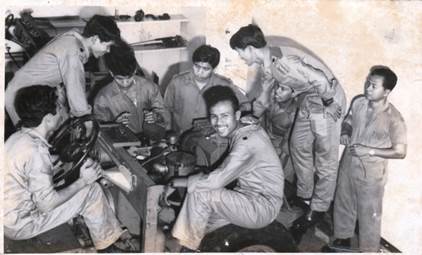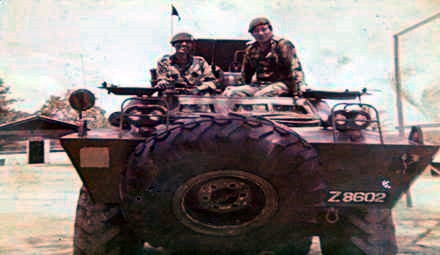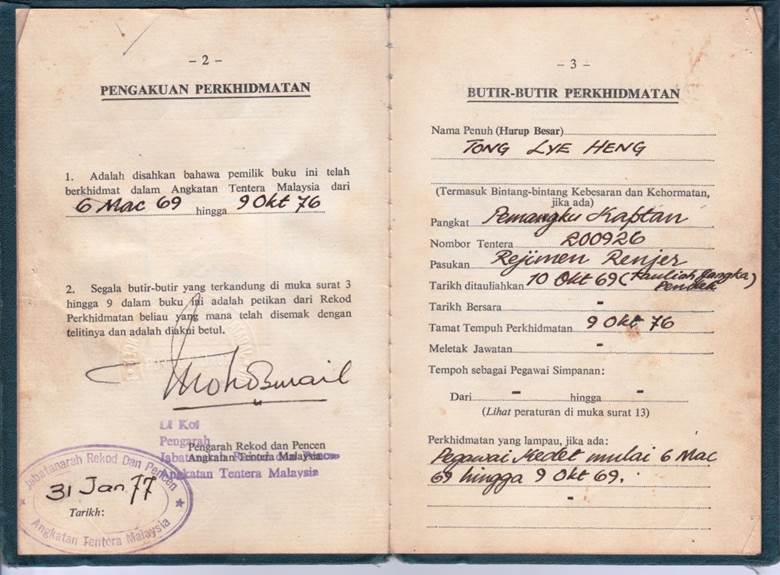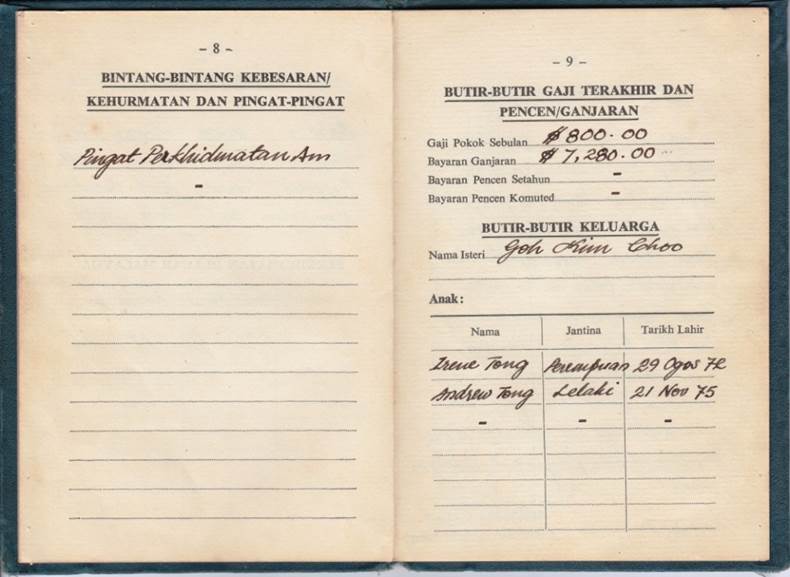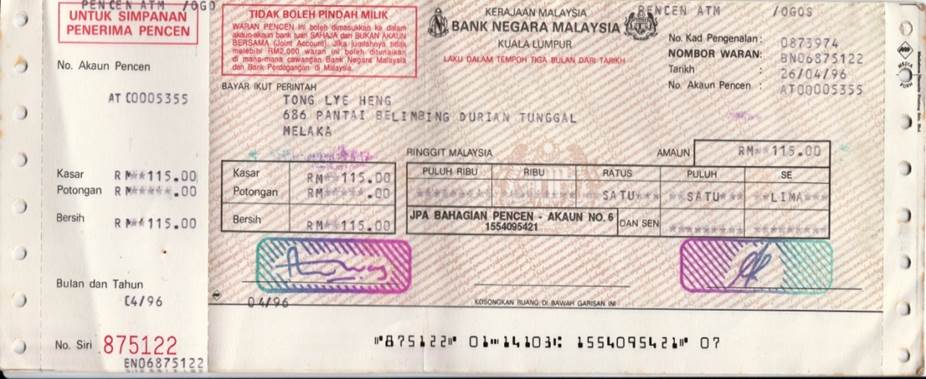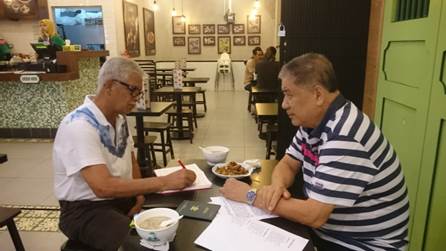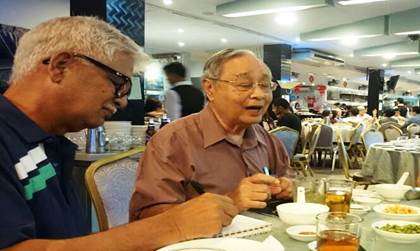|
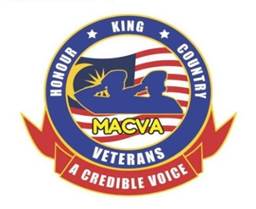 |
|
The Malaysian Army Chinese Veterans Association (MACVA) was officially set up on 31st August 2016, and then, it extended its membership drive to include all Army, Navy and Air Force personnel on 7th November 2017 under the auspices of the Malaysian Armed Forces Chinese Veterans Association (the MACVA acronym was however retained). It is today, a platform for our Armed Forces Chinese Veterans from all ranks to reminisce, recall or highlight stories of their contributions, no matter how big or small but always for the king and country. Some of these recalled events may or may not have been logged into the records of the national or military archives, but anecdotes and recollections are shared publicly whenever Veterans get a chance to congregate, socialize or just simply meet. One can also ask logically, if not for MACVA where else can these Veterans share such knowledge and experiences? MACVA is today a Veterans’ platform for all members to speak up credibly as to how they saw things while they were still actively serving.
MACVA has a mix of pensioned and non-pensioned soldiers, sailors and flyboys as life members. It is also a setup filled with commissioned officers from the Army, Navy and Air Force, irrespective of whether or not they belonged to the SSC, Regular Service Commission, Quartermaster, Special Duty, PD list or Reserves, but together, all are landing a hand pushing forward for MACVA to become that credible voice of society it objectivised from the onset of its formation.
Many interesting anecdotes have been intimated, and they make interesting reading and discussion, but most importantly they serve to remind all Malaysians that all service personnel, even those quickly forgotten SSC and PD list officers, had contributed and made huge sacrifices one way or another for King and country.
The following SSC and PD list Officers’ accounts should be logged, if not anywhere, at least in the MACVA Archives – Lest We Forget.
The “No Yong No Tong, No Tong No Yong” Story
At one of MACVA’s earliest gatherings, I met a gentleman, I was told he was a well-off successful businessman and is an army Veteran. He walked with a very slight limp. He is popularly addressed as Captain (Capt) Tong, and I gathered later that he is Capt Tong Lye Heng (Rtd), a SSC Officer of the Royal Ranger Regiment (RRR). I also learnt that he had seen action when he was in the service, shot by the Communist Terrorists (CT) and had survived the ordeal. He is today one of the founding members of MACVA.
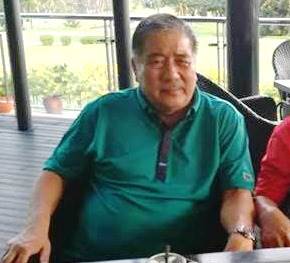 |
| Capt Tong Lye Heng (Rtd). |
Capt Tong celebrated his 71st (Chinese) birthday on 20th February 2018, my wife and I were invited guests for the event. At the birthday party, sitting adjacent to our table was an elderly gentleman dressed in batik, seated upright and conversing engagingly with the other members in his table, mostly Ranger Veterans. I wondered quietly who that gentleman was.
 |
| Dr Yong Boon How. |
Peaking the birthday celebrations, Capt Tong went on stage to state that his 71st birthday was very significant because he was shot by the CT’s in 71 (the year 1971), and also because an important friend had accepted his invitation to attend this particular birthday function. He spontaneously called upon a “Dr Yong” to come forward to join him at the stage, I scanned my sights for the reciprocating acknowledgement, and then my wondering was no more. The senior gentleman was in fact Dr Yong. Though truly taken by surprise; Dr Yong nevertheless acceded to Tong’s insistent calls.
Then, as if undertaking a testimony during a church congregation, Tong affirmed graciously, loudly and firmly to the crowd that he owes his life today to this Dr Yong Boon How, a National Service Professional Duties Officer who left as a Major (Maj) from the Malaysian Medical & Dental Corps (MMDC). Tong testified that Dr Yong had gone way beyond the call of duty and training to help save a badly wounded comrade injured in operations.
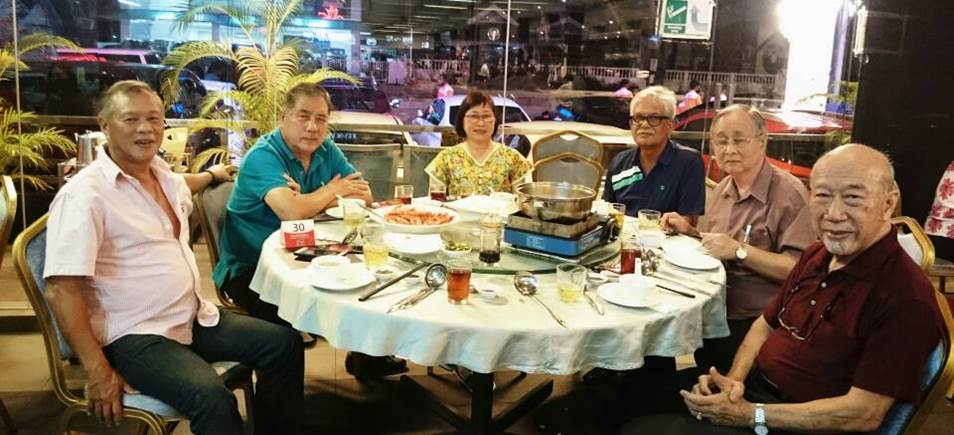 |
| One of the dinners hosted by Capt Tong (2nd Left) for Dr Yong (2nd Right). |
I attended two more dinners after that birthday celebrations, each time joining Tong entertaining Yong; I had noticed throughout, strong friendship and sincere gratitude Capt Tong showered towards Dr Yong. In that last entertainment dinner, Capt Tong had, as a matter of fact, sounded out that someone should write an article on this brave doctor on his tour of duties. Dr Yong however protested sheepishly that it should be Capt Tong’s story that should be officially cited in the military archives, he was after all the wounded combatant who suffered gunshot injuries in the frontline. Well, only then did I hear this rhythmic call ringing out from the two in a song – “No Yong No Tong, No Tong No Yong”.
Curiosity got the better of me.
Capt Tong Lye Heng (Rtd)
Tong born on 19th February 1948 in Melaka, completed his secondary education after passing his Overseas School Certificate examinations in St David High School in 1967. He was sure he still had the family support and advantage to continue his studies in medicine if he had chosen to; however, voluntarily he chose to join the army instead.
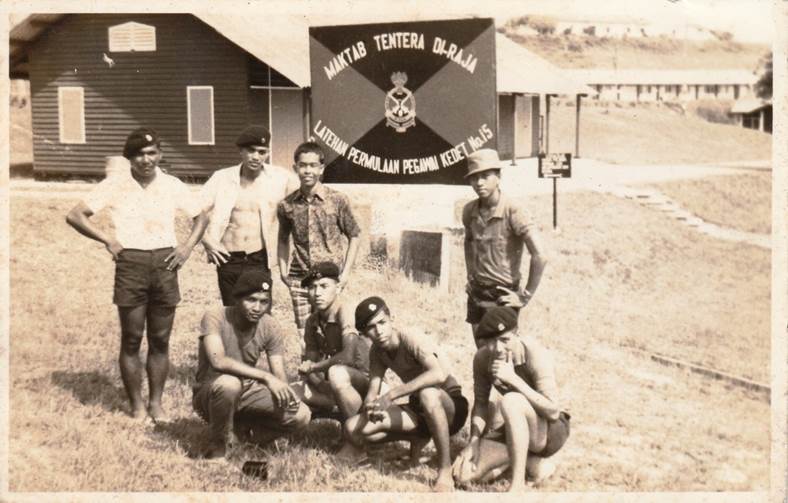 |
| Tong (squatting extreme right) during the RMC days. |
Tong underwent his initial officer cadet training at the Royal Military College (RMC) in Intake 15 on 6th March 1969 under the SSC scheme. He completed Officer Cadet Training on 9th October 1969 and was despatched to 1st Ranger Battalion, based in Kem Lapangan Terbang, Sibu in Sarawak, as a Second Lieutenant (2nd Lt).
On his very first day of reporting for duty to his Commanding Officer (CO), Lieutenant Colonel (Lt Col) Syed Abdul Aziz bin Syed Razak, the young and naive 2nd Lt Tong had volunteered a report that he had an officially registered marriage to Annie Goh Kim Choo, the registration undertaken after he had completed training and while he was on leave prior to being posted to this 1st Ranger Battalion. He went on to explain that a full official wedding ceremony had not yet been held – in Tong’s own words it’s only a “nikah gantung” or a hanging marriage in a direct English Language translation.
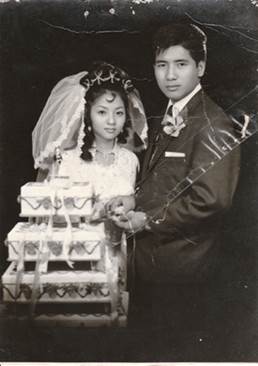 |
| The wedding celebrations finally fulfilled. |
The marriage announcement did not please his CO, whether it is out of love or merely to qualify for the marriage allowances, both these reasons were unimportant to his CO. Tong was not sure if it was a summary punishment, but in an immediate order he was tasked and despatched right away to the frontline forward base in Katibas, Sarawak, located at the Kalimantan Border. This remote location required quite some hours of a small boat ride upstream the river. Tong spent the next 6 months in this jungle location, assigned as a Platoon Leader of ‘A’ Company 1st Ranger Battalion under Capt Fabian Wong (another bravery cited officer who eventually retired as a Lt Col from the Joint Intelligence Directorate). Tong was living on rationed food and missing his first Chinese New Year away from home. This was truly his first test of character and a real exposure to the needs and sacrifices of a military personnel, and more so when the tasks were carried out in remote jungle locations far away from any civilisation. Any welcome breaks, in the form of getting back to civilisation, came only as and when he had to attend the requisite Officers Company Weapon and the Young Officers Tactical Courses.
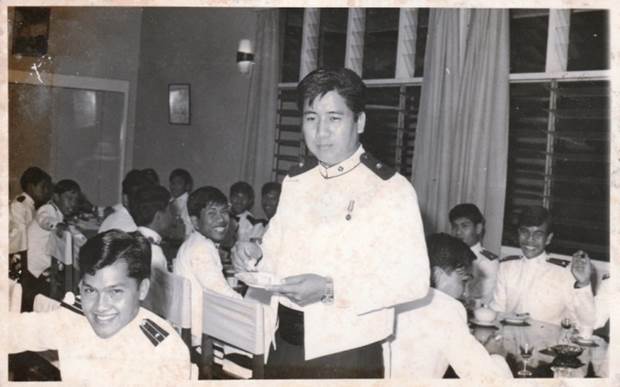 |
| 2nd Lt Tong is his Mess Kit. |
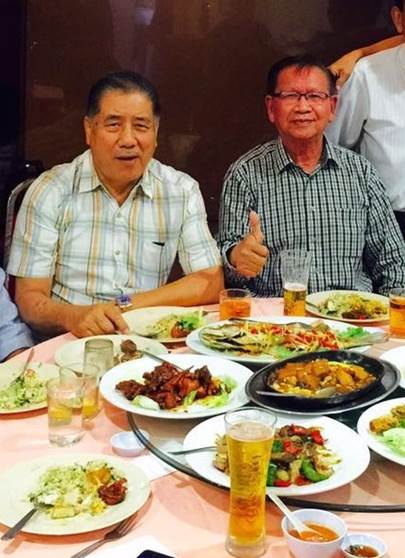 |
| Capt Tong & Lt Col Fabian Wong. |
In the meantime, a new 7th Ranger Battalion was formed on 10 May 1970, at Quetta Camp in Kluang, Johor with an initial batch of 202 recruits taken in to form 2 rifle companies. This battalion shifted to a new camp at Camp Batu Tiga, Jalan Mersing, Kluang in Johor. The Battalion’s complement was made out with the transfer of rifle companies from each of the 8th Malay, 2nd Ranger, 3rd Ranger and 4th Ranger regiments. With the transfer of these companies, 7th Ranger achieved its full regimental strength. 2nd Lt Tong was transferred to this new battalion from the 1st Ranger Battalion after his Sarawak stint.
On joining the Battalion, Kluang was soon devastated by severe floods; Tong was immediately appointed the Military Liaison Officer (MLO) for the next two months to help coordinate and manage the flood evacuation activities in Kluang District. After his civic duties and soon after the floods, he was immediately deployed to Klian Intan, Perak, under command of the Tactical Headquarters (HQ). Tong was reassigned to the frontline as a Platoon Leader and was operationally active at most time while posted in Klian Intan. The operation there was codenamed OPS KOTA - involving search & destroy activities.
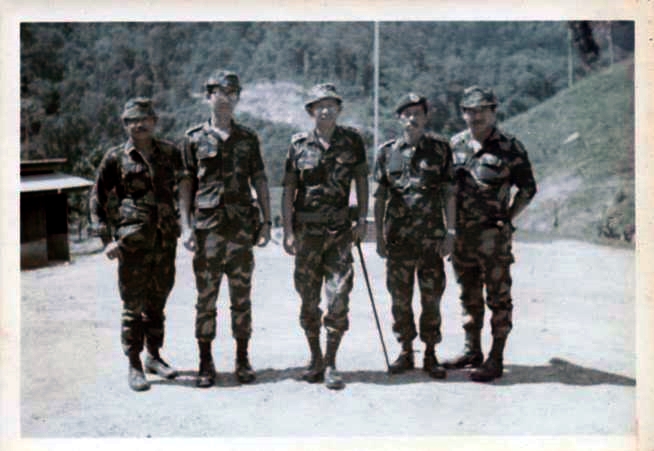 |
| 2nd Lt Tong (far right) with Lt Col Loh Lai Fook (centre). |
Tong’s Account - Search and Destroy OPS KOTA.
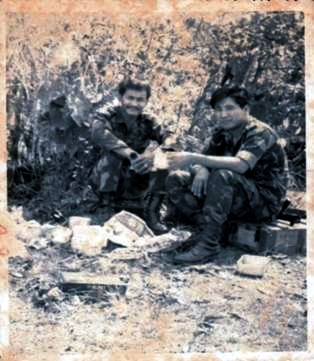 |
| 2nd Lt Tong during OPS KOTA. |
In one of the many activities carried out, and after spending an approximate three months in jungle under the search and destroy operations at the Kampung Lallang, Grik vicinity, Tong received specific instructions from his CO, Lt Col Hussein Bin Mohd Ali Piah, to detach his platoon to a prearranged pickup point off the main road, his platoon was then earmarked for their break – a scheduled Rest & Recreation (R&R). The pick-up and exchange point nominated at a main road was about a 10 hour hike by foot in complete combat outfit and equipment. This exchange was scheduled for the dawn of 9th June 1971.
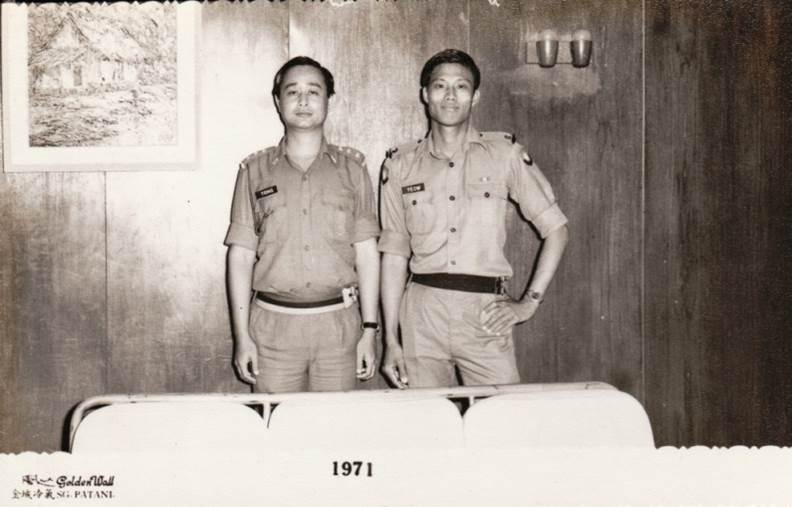 |
| Capt Dr Yong Boon How & 2nd Lt Peter Yeow C C. |
Tong was further informed that because his fellow colleague 2nd Lt Peter Yeow C C had not yet return from the Signal Officer Course he had attended, Tong was to act and take over Peter Yeow’s platoon as the relief, so there was no R&R for Tong himself. His immediate task was to lead this new platoon, a deployment of 26 soldiers, back safely into the same operational area, which will again involve another 10 hours journey on foot. The primary task for this new platoon, when positioned, was to set up an ambush point at a location within Kampung Lallang.
The 26 soldiers of the platoon were all new to Tong, he had no time to assess or get to know the soldiers personally or ability wise, as he would have done so in his normal and routine practices, but then he was also the relief in this instance. The soldiers, whom he was familiar with, those that had spent 3 months in the jungle together with him earlier, were already on their way back for their R & R. He would know exactly who, where and how to deploy these familiar men accordingly. Tong nevertheless was willing to go ahead with the task at hand with this new batch, as instructed by the HQ.
From the exchange point at the main road, Tong led his new platoon, hiking on foot to his pre-assigned location. While on passage, Tong had noticed, when they came across a river bank, there appeared a slight break in the thick canopy of the jungle that allowed some sunlight to stab through the jungle covers which brightened the river banks. With sunlight piercing through, he even noticed a number of river otters frolicking playfully in the water. He and his platoon were still about an hour’s journey from the pre-assigned area at this point of their journey, so they just carried on without much more thought put to that delightful scene.
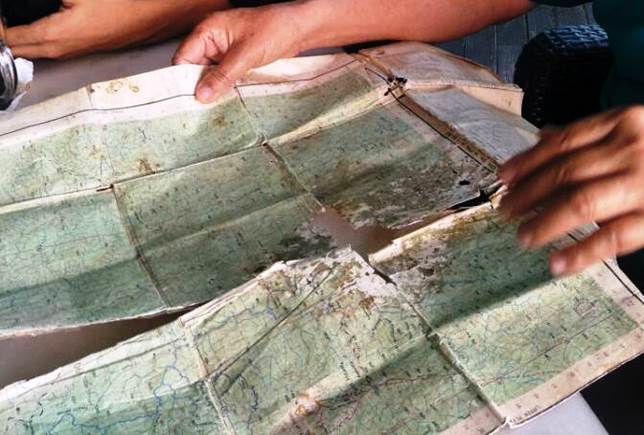 |
| Tong had kept the Location Map with sentimental value attached. |
On arriving at the assigned operations area, Tong quickly assessed, drew up and then guided his platoon to set out a rectangular defence perimeter, as it was already getting dark, darkness can also come unassumingly quick within minutes in any jungle terrain. Tong was convinced that his selected location was very well camouflaged and he could build his location defence using the natural surroundings to protect his platoon for the night against any eventualities. He was himself assured that the selected location would also serve as the designated ambush location that he had been instructed to set up.
In describing the setup of the defence perimeter, Tong pointed out that outwardly towards the east and west directions, these locations were well protected naturally by very deep overlooking ravines on both sides. With sentries placed strategically and overlooking from the top, any movements or intrusions below would easily be spotted from above. These locations were also an added advantage for the planned ambush set up later.
Tong decisively fortified his north and south locations of his perimeters with sentries 3 rows deep, for if any direct attack were to suddenly appear it can only occur through these passable north to south routes or vice versa. Towards the north is the Malaysia Thailand Border. Such north to south routes were rampantly used by the CT to infiltrate or retreat from Malaysia for their terror or counter terrorist activities organized by the Malaysian Armed Forces respectively.
As added knowledge and personal advantage, Tong had just recently returned qualified in the Intelligence Officer’s (IO) Course. All that he had been taught, guided and learnt were still fresh in his memory at that point of time. While on passage with his new platoon moving into the assigned location, he had put his military intelligence, appreciation and observation skills into good practice. He had already noticed that there were quite some indications and also inconspicuous signs of the CT presence in the vicinity – pebbles and stones physically rearranged, deliberate broken twigs or branches above eye level, routes, tracks, paths, etc. were all observed and noted. Expecting trouble, the platoon leader had ordered that no tents were to be pitched for the night. All sentries and soldiers were to be put on full alert and they were to make do with only body ponchos protecting them from the chill and the jungle moisture throughout the night.
On the morning of 10th June 1971, immediately after the morning stand-to, Tong set out early and quickly to further fortify his entire defence perimeter and the ambush location set up. He proceeded first to the south location and ordered that claymore mines be immediately placed forward of the perimeter, a first-line-of-defence mechanism. He then ordered that light machine gun locations be placed in tiers and at strategic locations. As his orders were being executed, he proceeded to look into the defense fortifications in the north sentry position, to provide similar reconnaissance and instructions there. He had already scheduled himself to return later to the south sentry positions to ensure that his instructions were properly executed, and specifically as ordered.
After he had completed his reconnaissance and instructions at the north perimeter posts, he was on his way back headed towards the south position as planned. As he was passing the central point of his entire rectangular defense perimeter, a sudden gunshot burst was heard from a distance coming from the south. A whizzing sound and then Tong felt a sharp piecing pain on his left hip; he was hit from that single burst of gunfire. He fell to the ground wounded and bleeding, but still conscious and lucid; he quickly made a “contact report” to HQ. A fire fight ensued while Tong was wounded on the ground still shouting out orders.
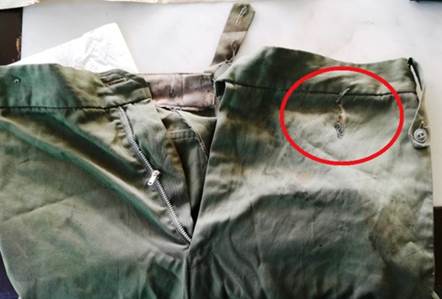 |
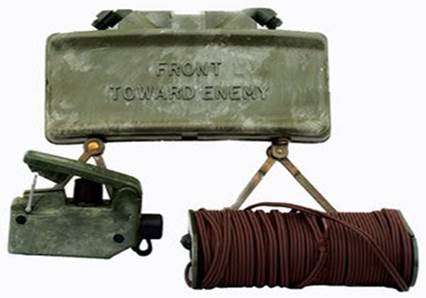 |
| Left - The trousers 2nd Lt Tong wore when he was shot on 10 June 1971. The hole in the trousers was where the bullet hit him, while the stains near the hole are blood stains from the wound. Right - Claymore Mine. |
Capt Tong had learnt very much later, that his most southerly outpost sentry had initially spotted two bogeys in sling arms unaware of the presence of the Ranger Battalion in the vicinity – the Battalion position was well camouflaged. That particular sentry had attempted to detonate the claymore mines, sadly the mines failed to detonate. The sentry then hastened into the light machine gun position and began squeezing the trigger, however, urgency or panic could have got the better of him. The sentry had not realised the weapon was still locked in the “Safe” mode instead of either “Rapid Fire” or “Automatic”. (A safety catch is a mechanism in all guns that is designed to prevent accidental or careless firing of the weapon. When in the “Safe”, a gun cannot fire at all). During that split second scramble and indecision, one of the intruders was able to engage his weapon first and fast; his single shot hit and wounded Platoon Leader 2nd Lt Tong.
Only two CT’s were initially sighted, it was never possible to tell hidden within that very thick forest if there were more of them hidden behind the two forward point men. The CT’s often send groups of armed men in a party of two to undertake their reconnaissance, before deploying their main fighting force. As the fire fight ensued, Tong with the aid of his Second in Command had requested artillery strikes to bombard the already predetermined south locations, as close as they were allowed to without endangering his own platoon, to deter any further intrusions. As Tong recalled, he could hear the shell projectiles whizzing above their heads, followed by sounds of deafening explosions.
Tong was bleeding profusely; efforts were made to stop the loss of blood from the wound with whatever first aid they can master at site. Tong had called in to the HQ to advise that he himself was badly hit. A medical evacuation (medevac) was necessary and urgent. Demoralised and also surprised, Tong was first instructed by HQ that he should be evacuated on foot back to the main road, some 10 hours journey away. Tong was well aware and had summed up consciously that he would not survive his wound or the journey ordeal on foot if he had followed through those instructions. Tong protested his chances of survival and countered that the only alternative left was through a helicopter medevac.
Tong quickly recalled the delightful scene where the otters were frolicking. He remembered that break in the jungle canopy, he was confident that a helicopter medevac via winching is possible at that location, even if a chopper landing was impossible. He pushed back to HQ for a helicopter medevac. HQ agreed and Tong was moved to this river bank position to facilitate the medevac.
As the firefight ensued, Capt Ngo Kim Seng, the ‘C’ company 2nd in-command who was operating approximately four to five map squares (one map square is one kilometer squared) north of Tong’s location, came charging all the way to render assistance in the event of heightened or expanded enemy actions. According to Capt Ngo, he and his men came running all the way from his location within two hours, covering almost four to five map squares in that dense jungle to reach Tong. It was Capt Ngo and his platoon that assisted in the medevac activities.
Two hours later, a single Nuri helicopter arrived at the scene, and then, what appeared to be a medical assistant (medic) was winched down from the chopper. The chopper and the medic were targets for the CT, attracting gun fire from underneath the canopy of the forest. Despite that, the brave medic was ably winched down from the helicopter. And when the offloading of the medic was done, the Nuri helicopter retreated in haste and out of sight.
 |
| Capt Tong (standing 1st from the right) and Capt Dr Yong (next to Tong) were from the 7th Ranger. |
The medic, Capt Dr Yong Boon How, proceeded to quickly treat and administer first aid to Tong, who was already pale looking by then. Dr Yong gave Tong a shot of morphine and administered Intravenous fluids (IV), which Tong himself believed helped stabilised his medical situation. Tong and Yong were both from the 7th Ranger serving in the Klian Intan area so they were both well acquainted with each other. After the first medical assistance was administered on the ground, the patient and doctor could only wait for the next step - the helicopter to return for the air medevac itself.
After a while, the same Nuri helicopter reappeared at the scene and winched Tong up into the chopper. It then flew away only to return later in order to pick Dr Yong up, this time accompanied by an Allouette helicopter. From the Allouette chopper that was circulating above, Lt Norman Sta Maria provided machine gun cover fire incessantly while the rescue operations were in progress.
Though already badly wounded and pale – the sounds of helicopter rotors, one hovering while the other circulating, the rescue operations, the fire fight from air and on ground and the medevac winching – these were all reminiscent of movies depicting the Vietnam War era, Capt Tong still recalls even today. With Tong and Yong already winched up, they were both airlifted to the Klian Intan medical facilities as a first stop. On arrival at Klian Intan, Tong and Yong were quickly transferred from the Nuri to the Allouette helicopter; speed in the arrival to the Hospital was paramount. Dr Yong flew with the wounded Tong to the Penang General Hospital. In Penang, Tong was rushed in to be immediately operated upon with massive blood transfusions and according to the doctors; the bullet missed his spine by about an inch, the urgent operations and the transfusions had saved his life. The chopper pilots, the Lt Norman air cover, the medic, the assistance from Capt Ngo and his men and finally the platoon leader’s own knowledge of the jungle had all blended into one perfectly timed human miracle on that day.
Tong was treated at the Penang General Hospital for about three months, and then spent another month at the Armed Forces Hospital, Terendak Camp in Melaka for further recuperation. Four months after the incident, he returned to the Sungai Petani HQ to resume duties. However, as he was no longer Medically Fit Everywhere (FE) for any further combat duties, he was not assigned to the frontlines again; instead he handled administration, tactics and intelligence in the war effort from then on. Tong was classified Base Everywhere (BE). Medical BE or Limited Everywhere (LE) classifications also impact one’s military career.
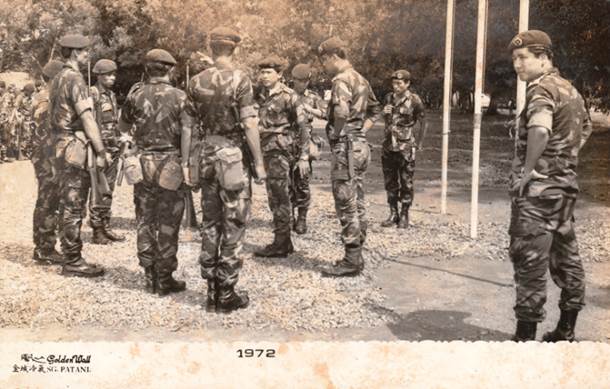 |
| 2nd Lt Tong (far right) together with brother officers at the
7 Ranger retraining programmes. |
Post Injury Activities
After having served as Platoon Leader in the 1st Ranger and 7th Ranger Battalions, Tong on return from medical leave was confined to only base duties. His first appointment after recovering from his injury was the Ketua Bahagian Tinggal 7th Ranger Battalion, or OIC Rear Party, Camp Lapangan Terbang, Sungei Petani. His main Regiment was already detached for OPS GERAKAN KHAS, OPS KG OPAL, OPS KUBANG and OPS LUNDU in East Malaysia. (These operations were launched after 15 of 7th Ranger's soldiers were ambushed and killed; three were wounded along the Lundu/Bau Road, Sarawak). As rear party, Tong was tasked with the duties to transfer, receive, identify family, inform and deliver on the funerals of eight of his fallen comrades.
| As the 7thRanger Battalion was formed to be a mechanised unit eventually, Tong’s next posting was as 7th Ranger Battalion Motor Transport officer for a spell. |
After the Motor Transport Officer stint, Tong was appointed as the 7th Ranger Battalion Intelligence Officer. During this period, Tong had worked closely with the Police Special Branch in Kulim, compiling some years of data to be superimposed with current Grade “A” operational intelligence. Tong was able to piece together what appeared to be a centre of gravity in CT operations for that area. He helped devised OPS SEDAR to strike the enemy in the Gunung Bongsu location, working with his CO equipped with his new findings. Though it took some time before it became a fruitful operation, Tong exclaimed that “We managed to kill two CT’s in that operation,” this was perhaps the retribution that Tong had quietly sought, to strike back at the enemy who almost took away his life. He had after which decided, with all his limitations in full fitness and promotional opportunities, there was little scope left for him to advance in the Armed Forces. Most importantly, the killing of the two CT’s near Dublin Estate, Kedah at the end 1975 had convinced him that his efforts as Intelligence Officer had paid off handsomely, and a closure for him against the CT’s fulfilled. His sojourn in the military has run its course; it was timely for him to call it a day from the Malaysian Armed Forces.
After that last event, Capt Tong applied for and was honourably discharged. After being medically boarded for his injuries, he left the Ranger Regiment on 9th October 1976. His disciplined life in the army had taught him incredible lessons that have helped him adapt to the civilian life after the army. He had joined the plantation industry as a manager from 1979-1996. When he was in the army, he had learnt valuable lessons in people and team management as head of a platoon and OIC. “That experience translates perfectly to managing a plantation,” he said. After 17 years in the plantation industry he switched occupation to work in the maritime bulk carrier shipping sector. Now, he runs his own cargo shipping company and is a contented businessman today.
Maj Dr Yong Boon How (Rtd) KKD
Yong was born on 11 December 1938 in Georgetown, Penang. He had his early education in Anderson School, Ipoh, Sultan Sulaiman English School, Kuala Terengganu and Penang Free School in Penang. Yong was a troop leader and a Queen Scout while schooling. Yong graduated in his Bachelor of Medicine, Bachelor of Surgery (MBBS) qualifications from the Nagpur University, India in 1967. While in Nagpur, he was the Nagpur Foreign Association President in 1967 and also the outstanding Jaycee of the year in 1964. He returned to serve a one year Housemanship at the Penang General Hospital and was posted to the Kota Bharu General Hospital in Kelantan for a spell. He was then appointed the Medical Officer in Charge (MOIC) in Kuala Kerai, Kelantan, and then, it was time to fulfil his National Service requirements. Having already served in the rural areas, signing up for military service to complete his National Service was actually a Hobson’s choice.
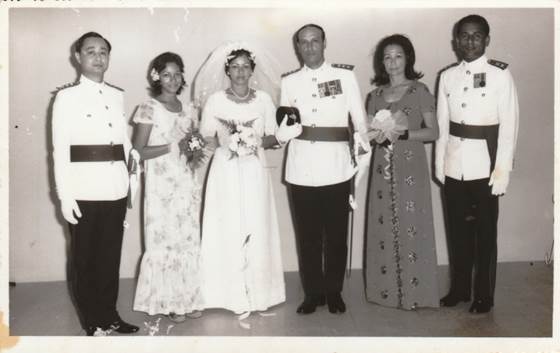 |
| Dr Yong while with Terendak Hospital Melaka. |
Dr Yong joined the Malaysia Medical & Dental Corps (MMDC) on 1st February, 1971 in the 11th MMDC Intake to fulfil his National Service requirements. He was despatched to the Armed Forces Hospital, Terendak Camp in Melaka for indoctrination and familiarisation trainings and then tasked to the 7th Ranger Battalion based in Kluang, Johor. After reporting and formalisation in the Kluang Base, he was sent right away to the 7thRanger Battalion stationed at Sungai Petani and Klian Intan.
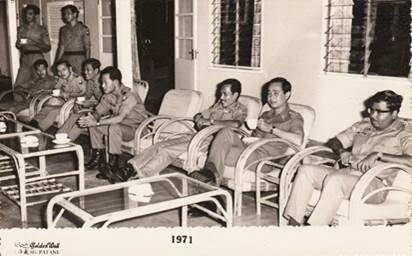 |
| Dr Yong (2nd from right) with the CO Lt Col Hussein Ali Piah (3rd from right). |
After serving the 7th Ranger Battalion for 6 months, Dr Yong had a second tour in the Armed Forces Hospital, Terendak Camp in Melaka. In his final years of his military service he was attached to KD HANG TUAH and KD MALAYA as the Medical Officer and Senior Medical Officer (SMO) respectively in the Royal Malaysian Navy Base in Singapore.
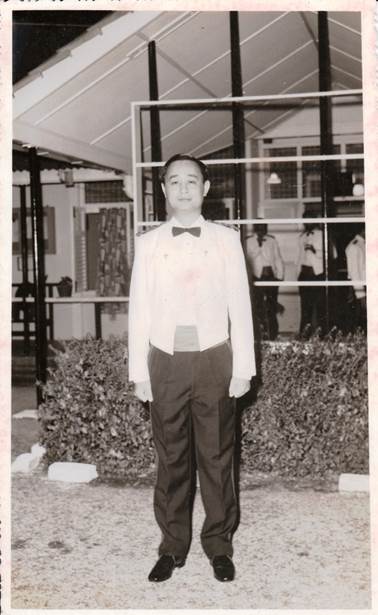 |
| Dr Yong in Mess Kit in Terendak Camp. |
He completed his National and Short Service on the 29th February, 1976. Dr Yong was awarded the Malayan Academy of Family Physician (MAFP) whilst he was in private practice until he retired recently in Terengganu. Dr Yong was the Rotary Club Kuala Terengganu President from 1992-1993.
Dr Yong Boon How married Dr Deepti Das, a Specialist Radiologist who is now in private practice in Singapore. Incidentally, she was the first qualified lady radiologist in Malaysia. They have two sons, Dr Joy Yong Chi-liang and Dr Robin Yong Chi-weng, both now residing and practising in Adelaide, Australia.
Yong’s Account - Search and Destroy OPS KOTA Operation, Klian Intan, Perak
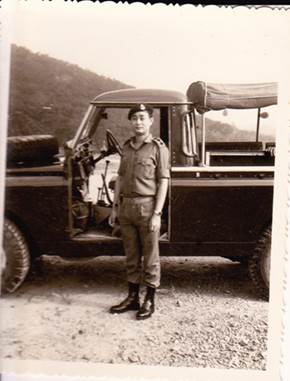 |
| Dr Yong in Klian Intan. |
On arrival at the 7th Battalion base in Sungei Petani, Dr Yong reported for official duty there. He was told he would be sent out to the Klian Intan operational area immediately. While waiting for his transport to Klian Intan, he had noticed a new supply of 12 bottles of IV fluids on a trolley. With approval, Dr Yong collected 6 IV bottles and placed them into his bag and made his way to Klian Intan.
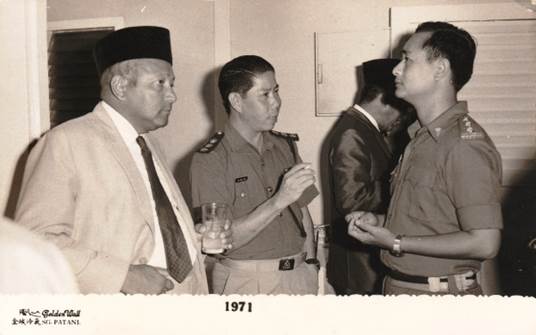 |
| Dr Yong Interacting with other Relevant Security Bodies. |
While attached to the 7th Ranger Battalion in Klian Intan, Dr Yong had attended to the town people daily as part of the military hearts and minds project. This was apart from his routine medical coverage provided for the entire 7th Ranger Battalion; there were no civilian doctors in the area during that period.
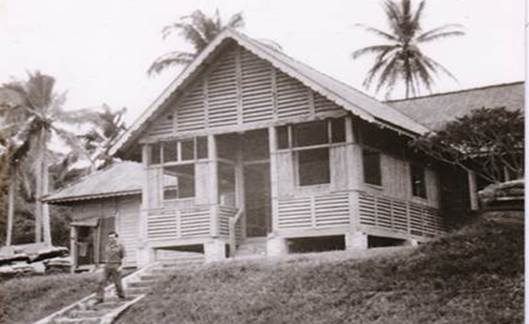 |
| Klian Intan Clinic where Dr Yong operated. |
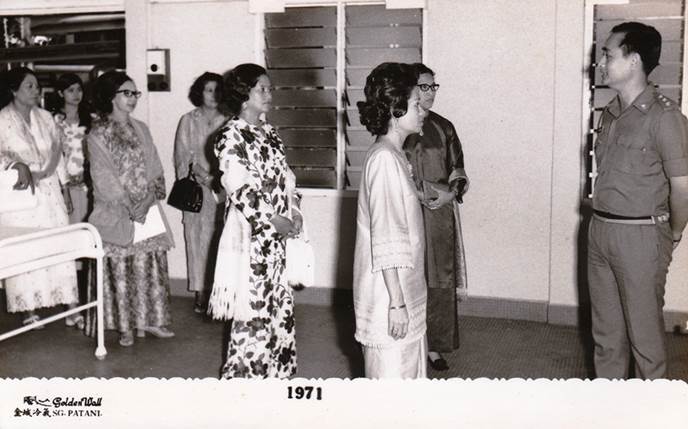 |
| Hearts & Mind Family Day Visit to Clinic. |
On 10th June 1971, Capt Dr Yong was informed in his Klian Intan clinic that a fellow Ranger comrade had just been shot in his left thigh by the CT deep in the jungle. As a helicopter cannot land, due to the tall trees in thick canopied jungle, he was asked if he would be prepared to be winched down from a helicopter to render first aid and assistance to the wounded in a medevac operation. Dr Yong said he had no idea what winching down from a chopper was all about, he was never trained nor exposed to do so. Incidentally, this was before winching was part of the training for military doctors. He nevertheless was quite prepared in order to rescue a fellow comrade in need. On agreement, his sergeant placed a white Red Cross arm band over his left arm sleeve and he proceeded with the task at hand.
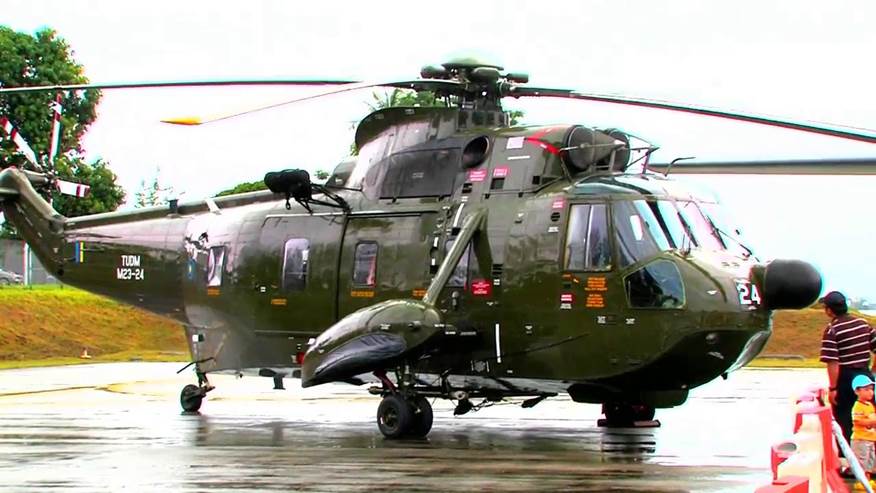 |
| Nuri Helicopter. |
The Nuri helicopter flew over a river bank deep into the jungle and immediately winched Dr Yong down from a maximum permissible height. Yong recalled that he could see the tree tops swinging violently coaxed by the force of chopper rotor blades and small figures at the river bank in anticipation; he was just admiring the view not realizing at all that he and the chopper were target gunfire from the CT. He was nonetheless successfully lowered and the Nuri chopper hastened away quickly out of sight. Dr Yong proceeded immediately to the wounded comrade; he was pale and lifeless due to a massive blood loss. Dr Yong did not initially recognise that it was his fellow officer colleague 2nd Lt Tong that was wounded and immediately administered a shot of morphine and IV to replace fluids and stabilise Tong. Dr Yong recalls today, had he not collected those 6 bags of IV Fluids, this story would have been written differently.
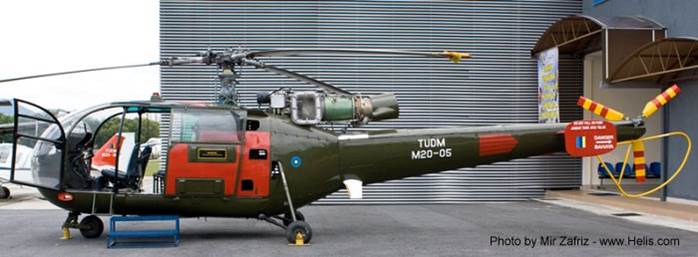 |
| Allouette Helicopter. |
Two helicopters came back, the Nuri helicopter winched Tong and Yong on board. Yong recalls, my helicopter was fired upon by the CT again, Lt Norman Sta Maria returned fire from the Allouette helicopter that was circulating around to provide cover. Dr Yong flew with the wounded officer to Klian Intan and then transferred the wounded to the Allouette chopper for the medevac to the Penang General Hospital, where the patient was operated upon with massive blood transfusions. On arrival and landing at the Hospital Padang, Tong was immediately handed over to the capable hands of the Penang doctor and surgeon, who both apparently had instinctively delayed their trip home when they heard the rotors of the Allouette approaching the hospital. Yong handed over his patient to expert care of the hospital, his task was completed.
Dr Yong made his way back to Klian Intan in civilian clothes, and by bus. When he had offered to pay his bus fare, the conductor had said, “No need, doctor.” Dr Yong was taken by surprise that the bus conductor had recognised him, but had assured himself silently that the conductor could also have been one of his patients treated under his efforts in the hearts and minds project. He was not unaware also, it was common for Communist sympathisers to mingle freely amongst citizens in Klian Intan. Whoever that conductor was it was immaterial then, as Dr Yong also recalled, the shooting incident was already broadcasted over southern Thailand the following day over the CT radio network. He noted, news was indeed current and had traveled fast, he was glad he could return to duties unscathed anyway.
Post that eventful day, Dr Yong soon learnt that a large CT camp was located and reported in the Malaysian Thailand border. A large scale military operation was to be launched, and a few battalions had already surrounded the location ably supported by the military artillery. The 7th Ranger Battalion was sent in to comb through the location (mopping up), and this was supposedly a secret operation. However Dr Yong noted coyly, the Sungai Petani Township was flooded with military vehicles and men buying instant noodles and salted fish. The usual ration were too heavy to be carried in the jungle terrain during such operations, the secret operations was a clear give away in town if any, he had thought to himself. The CO and MO were also required to go into the jungle with the troops instead of being housed at the base camp this time around. Dr Yong remembers clearly, “We had hiked the whole day in a difficult terrain and different weather conditions; we were most of the time soaked in rain water. While in the jungle terrain, Dr Yong’s tent was hit by a collapsing dead tree, he was lucky that he was not in the tent at that moment. The troops were supplied rations by air. In recollection, Dr Yong recalled that they had received rations dropped from the air but it was too late for the choppers to make another sortie to deliver the needed fuel – “we had plenty of food but were short on fuel”. The operation lasted from 17th September until 5th October 1971 and the end results were, “there were no contacts made”.
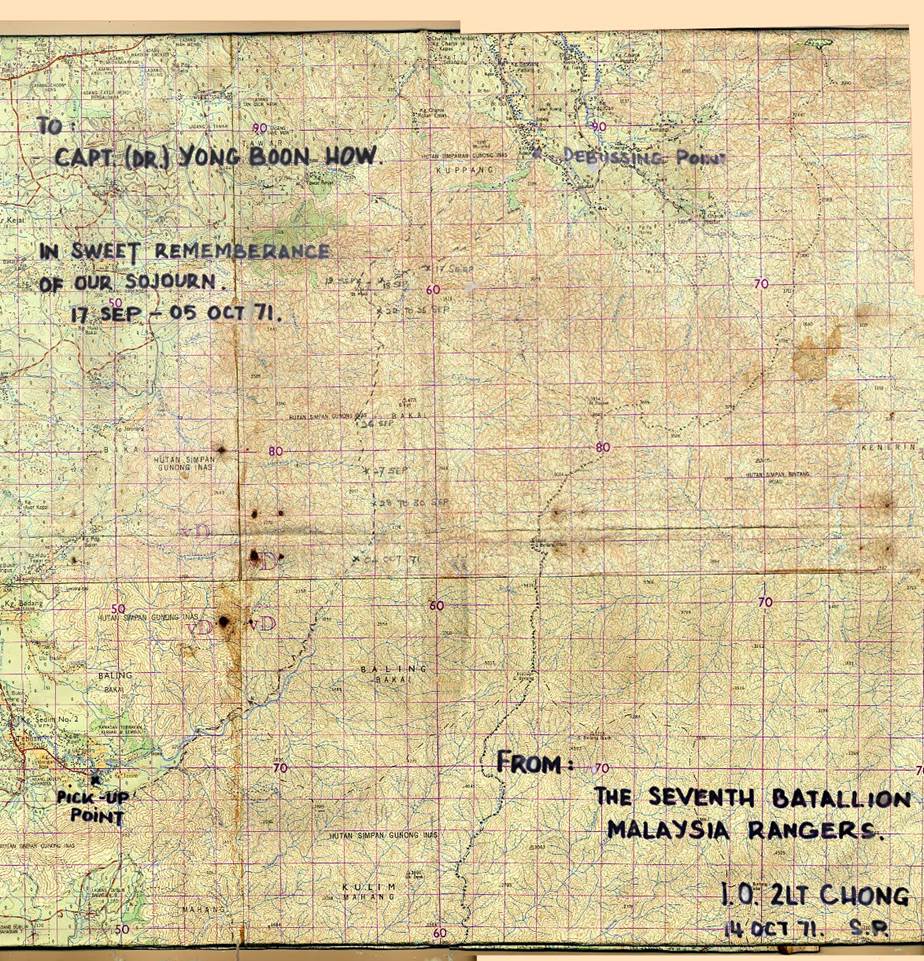 |
| A Map Memento presented to DR Yong by 7th Battalion. |
On completion of the operations Dr Yong’s CO, Lt Col Hussein bin Mohd Ali Piah, had intimated to him that all times there were two men keeping a close watch on the Doctor’s safety throughout the operations. Dr Yong is still emotional each time he recalls the event. How could he forget, his stomach could not handle normal food after two weeks of rations for he suffered from severe abdominal colic and diarrhea for a while.
The Klian Intan posting, the IV episode, the eventful Tong incident and the jungle operations had taught Dr Yong the difficulties and hardship the troops on the ground faced and the risk of being ambushed daily. He appreciates their hard lives, theirs are true sacrifices. Dr Yong was the first doctor in Malaysia who carried out his duty at the frontline instead of the basecamp.
His last two postings were to KD HANG TUAH as the MO and KD MALAYA as the SMO. Tun Abdul Razak was on board KD HANG TUAH when the frigate sailed from Port Klang to Penang; Dr Yong was the MO onboard. Dr Yong sailed in a variety of naval vessels in West and East Malaysia. He also experienced a Jackstay transfer with the Indonesian navy in a joint exercise.
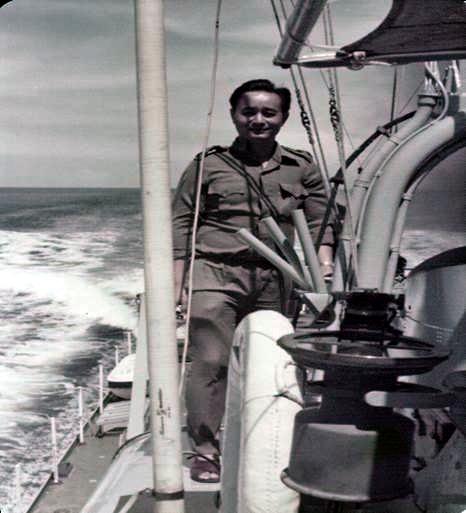 |
| Dr Yong Onboard a RMN Patrol Craft. |
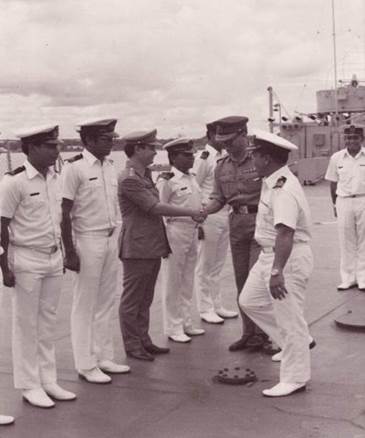 |
| Onboard a RMN Ship being introduced as part of the Navy Team. |
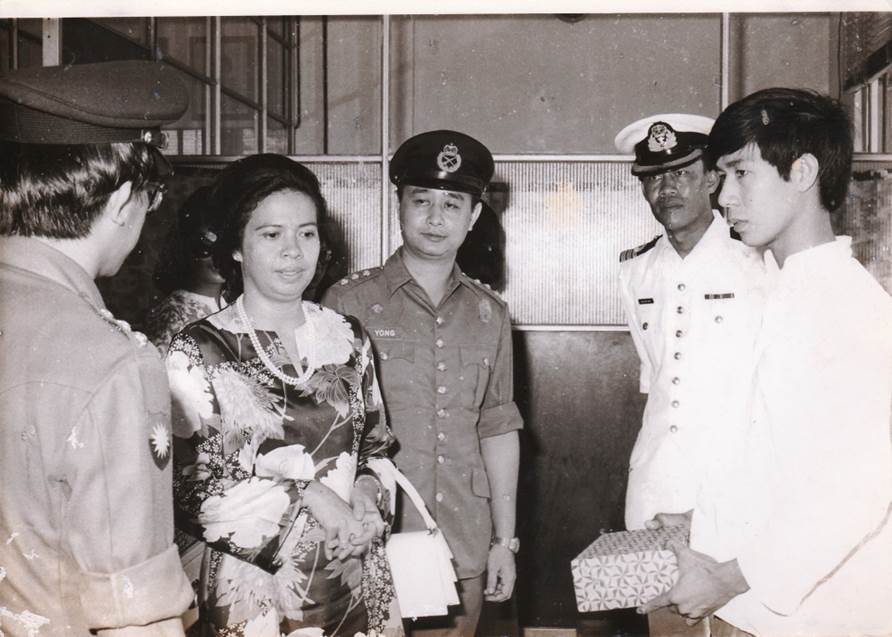 |
| Dr Yong as SMO in KD MALAYA. |
Epilogue
1. Tong Lye Heng completed his tour of duties in the rank of Acting Capt.
2. Tong Lye Heng received a General Service Medal or Pingat Perkhidmatan Am (PPA) for all his contributions throughout.
3. Tong Lye Heng was medically boarded for his wounds and injury, with the assistance of Dr Nadarajah. He was assessed by the board that he sustained a 10% disability function, which then equated approximately to RM60.00 per month medical benefits. That figure inflated to be RM115.00 per month in 1996 as seen in this unclaimed cheque.
4. When scrolled in the web, the only public record for Tong Lye Heng is this caption in a non-official 7th Ranger Blog:
Roll of Honour
Lt Tong Lye Heng
Location: Jungles of Perak
Date: 10 June 1971
Incident: During OPS KOTA was shot by the Enemy
5. There are no military citations found for Dr Yong Boon How.
Recorded by Lt Soon Tet Leong RMN (Rtd) for the MACVA Archives.
6 Jun 18
















